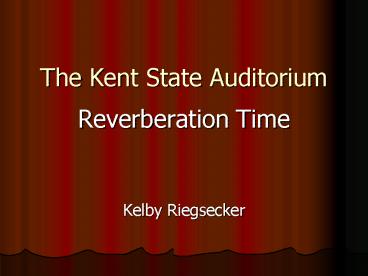The Kent State Auditorium - PowerPoint PPT Presentation
1 / 15
Title:
The Kent State Auditorium
Description:
1914 the original building's intended use as a library, gym, ... BALCONY. Sound Level ... BALCONY. 125 hz 250 hz 500 hz 1000 hz. Sections. Reverberation Time ... – PowerPoint PPT presentation
Number of Views:192
Avg rating:3.0/5.0
Title: The Kent State Auditorium
1
The Kent State Auditorium
- Reverberation Time
- Kelby Riegsecker
2
Building Description
- Kent State University Auditorium
- 1914 the original buildings intended use as a
library, gym, and executive offices - 1931 stone façade added and extended front of
building another 15 feet - 1999 phase 1 included renovations in the
auditorium for large lecture use, but also for
use as a performance hall - Phase 2 included office renovations and the new
atrium space - 65,000 sq ft auditorium which seats over 800
people
3
Hypotheses
- The auditorium will have a calculated
reverberation time between 1.4-1.6 seconds, which
is suitable for a general purpose auditorium and
most orchestral performances. - The actual measured reverberation time will be
between /- 0.2 seconds of the calculated time.
4
DEFINITIONS
- Architectural Acoustics
- the technology of designing spaces, structures,
and mechanical systems to meet hearing needs
wanted vs. unwanted sounds or noise
Sound for our purpose of study it is simply an
audible signal human ear has a detection range
of 20-20,000 hertz
Reverberation the persistence of sound after the
sound source has ceased, as a result of repeated
reflections in an enclosed space. most simply put
it is the time required to drop 60 decibels below
the original sound level.
5
Part I Testable Hypothesis
Tr K x V/A
Reverberation Time
6
HYPOTHESIS 1 BETWEEN 1.4-1.6 seconds
Optimum reverberation at midfrequencies (500-1000
hz)
7
AVERAGE Midfrequency Reverberation 1.82 seconds
Optimum reverberation at midfrequencies (500-1000
hz)
8
Part II
- Tools required
- Sound level meter
- Digital Sound Recorder
- Test Tone Generator
- Photoshop
- Excel
- SpectroGram 8
- Amplifier w/ Loudspeakers
9
Process
Once the plans were obtained, a 12 x 12 grid
was used to take measurements at the different
frequencies.
FIRST FLOOR
BALCONY
10
Sound Level
Producing 115 db from the source, the sound level
was recorded in db at each frequency (shown below)
FIRST FLOOR
125 hz 250 hz 500
hz 1000 hz
BALCONY
11
Sections
12
Reverberation Time
500 hz
- The midfrequency ranged from 1.1 second to 1.3
seconds. These two graphs represent a typical
analysis of the time taken for the sound to
return to its original state.
1000 hz
13
HYPOTHESIS 2 BETWEEN 1.2-1.8 seconds
Optimum reverberation at midfrequencies (500-1000
hz)
14
HYPOTHESIS 2 BETWEEN 1.2-1.8 seconds
Optimum reverberation at midfrequencies (500-1000
hz)
15
Analysis Conclusion
- Hypothesis 1 was disproved with a reverberation
time of 1.82 seconds as opposed to 1.4-1.6
seconds. - Hypothesis 2 was proven with a reverberation time
between 1.1-1.3 seconds compared to 1.2 seconds. - The variation between the two numbers could be
due to a number of factors - Calculated area and absorption coefficients are
not accurate - Sound waves collected have been overanalyzed
- Spectrogram db error
- The acoustical value is appropriate for the
multipurpose use of the space. - The further study of the disproved hypothesis
lead to a more accurate calculation of the
reverberation time.

